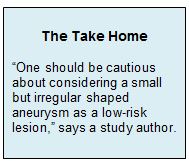Key Points:
- Registry study compares ruptured with unruptured saccular intracranial aneurysms
- Irregular shape emerges as the primary factor linked with rupture
Irregular shape is a significant risk factor for rupture of saccular intracranial aneurysms independent of location and patient characteristics. Importantly, even small aneurysms may have a considerable risk of rupture if they are irregular in shape, according to a registry study published in the May 2016 issue of Stroke.
Juhana Frösen, MD, PhD, and colleagues at Kuopio University Hospital (Kuopio. Finland) obtained data from a population-based registry of 4,417 patients treated for 6,327 saccular intracranial aneurysms at their neurosurgical center between 1980 and 2014. After some patients were excluded from the study due to incomplete information, the final population consisted of 3,030 unruptured and 2,784 ruptured aneurysms in 4,074 patients.
As expected, the median size of ruptured saccular aneurysms was larger than for unruptured (7 mm vs. 4 mm, P < .000), but both aneurysm location and patient characteristics were associated with size at rupture. As many as 38% of ruptured aneurysms were smaller than 7 mm, and 18% were smaller than 4 mm. Among the saccular aneurysms that ruptured when smaller than 7 mm, 87% had an irregular shape.
Multivariate analysis revealed that irregular shape predicted presentation as ruptured vs. unruptured far better than patient smoking status or PHASES score, a metric that takes into account population, hypertension, age, size, earlier subarachnoid hemorrhage from another saccular aneurym, and site (table 1).
A Sensitive Independent Marker
“Irregular shape has been associated with aneurysm rupture before, and even previously shown to be a risk factor rupture,” Dr. Frösen told WLNCMD in an email.
“The novelty of this large population-based series with a 35-year follow-up is that it demonstrates that irregular shape is a very sensitive, independent marker for those aneurysms that will rupture,” he said. That shape also indicates rupture risk even in smaller aneurysms “is very important,” Dr. Frösen stressed, “since although overall small (< 7 mm) aneurysms have a low or very low rupture-risk, some of them will nevertheless rupture.”
“One should be cautious about considering a small but irregular shaped aneurysm as a low-risk lesion,” he cautioned. “However, one should also remember that we do not yet know how specific irregular shape is as a marker of rupture risk,” especially when it pertains to small aneurysms.
“One should also always remember to weigh the risk of intervention against those of conservative management,” he advised. “Conservative management and follow-up may still be the best option for some irregular shaped or otherwise rupture-prone aneurysms if the risks associated with the intervention are very high.”
Source:
- Lindgren AE, Koivisto T, Björkman J, et al. Irregular shape of intracranial aneurysm indicates rupture risk irrespective of size in a population-based cohort. Stroke. 2016;47:1219-1226.
Disclosures:
- Dr. Frösen reports no relevant conflicts of interest.

